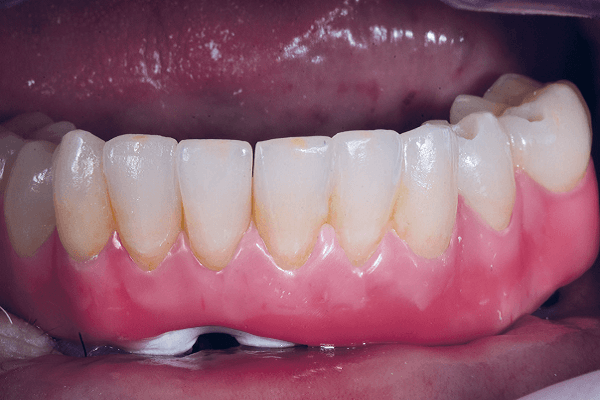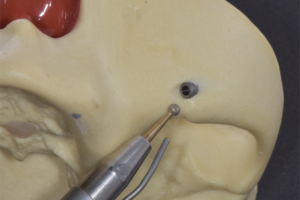RESUMO
O objetivo deste trabalho foi apresentar uma proposta reabilitadora alternativa no tratamento dos defeitos de recessão mandibular em pacientes oncológicos. Na primeira fase, foi diagnostico um carcinoma de Ackerman, sendo removido em conjunto com os dentes da hemimandíbula esquerda. Seis anos depois, um novo carcinoma espinocelular foi detectado no lado mandibular direito, sendo removido em conjunto com a dentição, seguido da colocação de uma placa de titânio. Dois anos depois, seis implantes dentários foram posicionados entre os forâmens mentuais. As arcadas foram moldadas de forma convencional. Os modelos de gesso foram escaneados e o projeto digital da prótese foi concebido desenhando a infraestrutura em PEEK recoberta por resina rosa e com pilares para dez coroas individuais de dissilicato de lítio para cimentação. A tecnologia CAD/CAM devolveu o paciente às suas atividades normais com simplicidade, precisão e previsibilidade.
Palavras-chave – Reconstrução tumoral; PEEK (poliéter-éter cetona); Implantes dentários; Prótese total fixa sobre implantes; Coroas de dissilicato de lítio.
ABSTRACT
The aim of this paper is to present a prosthetic rehabilitation alternative to treat ressection mandibular defects on oncological patients. On the first phase, the patient was diagnosed with a Ackerman’s carcinoma, and had all his left teeth and the hemi-mandible surgically removed. Six years later, the patient presented again with a new spinocellular carcinoma on the right side, but this time along with tooth removal and the hemi-mandibular area, a titanium plate was installed. Two years later, six dental implants were placed between the interforaminal area. Then, conventional impressions were taken from the dental arches. Thus, dental casts were scanned and the final prosthodontic digital project was conceived with the infrastructure milled in PEEK and vennered with pink porcelain, still presenting 10 abutments to receive cemented lithum disilicate crowns. The CAD/CAM technology was capable to return the patient to his daily activities with simplicity, precision, and predictability.
Key words – Tumor reconstruction; PEEK (polyetheretherketone); Dental implants; Complete fixed implant-supported prosthesis; Lithium disilicate crowns.
Referências
- Ackerman LV. Verrucous carcinoma of the oral cavity. Surgery 1948;23(4):670-8.
- Cannon CR, Hayne ST. Concurrent verrucous carcinomas of the lip and buccal mucosa. South Med J 1993;86(6):691-3.
- Stawarczyk B, Beuer F, Wimmer T, Jahn D, Sener B, Roos M et al. Polyetheretherketone – a suitable material for fixed dental prostheses? J Biomed Mater Res B Appl Biomater 2013;101(7):1209-16.
- Ahmed MA, El-Shennawy M, Althomali YM, Omar AA. Effect of titanium dioxide nano particles incorporation on mechanical and physical properties on two different types of acrylic resin denture base. World J Nano Sci Eng 2016;6(3):111-9.
- Testori T, Meltzer A, Del Fabbro M, Zuffeti F, Troiano M, Francet-ti L et al. Immediate occlusal loading of Osseotite implants in the lower edentulous jaw. A multicenter prospective study. Clin Oral Implants Res 2004;15(3):278-84.





